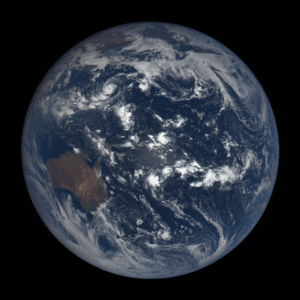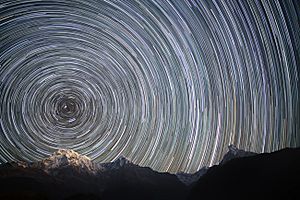Earth's rotation facts for kids
Earth's rotation is when our planet Earth spins around its own center line, called an axis. It also includes how this axis changes its direction in space. Earth spins towards the east, which is called prograde motion. If you could look down from the North Pole (near the star Polaris), Earth would appear to spin counterclockwise.
The North Pole is the spot in the Northern Hemisphere where Earth's spin axis meets the surface. This is different from the North Magnetic Pole. The South Pole is the other spot where the axis touches the surface, located in Antarctica.
Earth spins once in about 24 hours compared to the Sun. This is what we call a day. But it spins once every 23 hours, 56 minutes, and 4 seconds compared to distant stars. This is called a sidereal day. Earth's spin is actually slowing down a tiny bit over time. This means days were shorter in the past. This slowdown is caused by the Moon's pull on Earth.
Special Atomic clocks show that a day today is about 1.7 milliseconds longer than it was a century ago. This slow change means we sometimes add a "leap second" to UTC to keep our clocks in sync. Old records of space events show that the length of a day has increased by about 2.3 milliseconds per century since the 8th century BCE.
However, scientists noticed something interesting in 2020. Earth started spinning faster after many decades of slowing down. On June 29, 2022, Earth completed its spin 1.59 milliseconds faster than 24 hours. This set a new record! Because of this, engineers are now talking about possibly adding a 'negative leap second'.
This increase in speed might be due to several things. These include the complex movements of Earth's hot, liquid core, its oceans, and its atmosphere. The Moon's pull also plays a role. Even climate change might be a factor, as melting ice at the poles changes Earth's shape. Earth is shaped like a slightly flattened ball, bulging at the equator. When ice melts, the poles "rebound" (move up) from the lost weight. This makes Earth more spherical. When mass moves closer to the center, like a spinning ice skater pulling their arms in, the object spins faster. This is due to something called Conservation of angular momentum.
Contents
History of Understanding Earth's Spin
Long ago, some ancient Greeks from the Pythagorean group believed Earth rotated. One of the first was Philolaus (around 470–385 BCE). His ideas were complex, even including a "Counter-Earth" spinning daily around a central fire.
Later, in the fourth century BCE, thinkers like Hicetas, Heraclides, and Ecphantus also thought Earth rotated. But they didn't suggest Earth went around the Sun. In the third century BCE, Aristarchus of Samos was the first to suggest the Sun was at the center.
However, Aristotle (fourth century BCE) disagreed with Philolaus. He believed that the stars were fixed on a sphere that rotated around a stationary Earth. Most people after him, especially Claudius Ptolemy (in the 2nd century CE), agreed. Ptolemy even thought Earth would be destroyed by strong winds if it rotated!
In 499 CE, the Indian astronomer Aryabhata suggested that the spherical Earth spins on its axis every day. He said the apparent movement of the stars was just because Earth was moving. He used a great example: "Just as a man in a boat going in one direction sees the stationary things on the bank as moving in the opposite direction, in the same way to a man at Lanka the fixed stars appear to be going westward."
During the 10th century, some Muslim astronomers also believed Earth rotated. Al-Sijzi (died around 1020) even invented a special astrolabe based on this idea. Later, in the 13th century, it was noted that "According to the geometers, the Earth is in constant circular motion, and what appears to be the motion of the heavens is actually due to the motion of the Earth and not the stars."
In Europe, Thomas Aquinas and others in the 14th century followed Aristotle's view. It wasn't until Nicolaus Copernicus in 1543 that the modern idea of Earth's rotation became widely accepted. Copernicus argued that if Earth's movement was "violent," then the stars' movement would have to be much more so. He also pointed to examples of how motion can be relative. For Copernicus, this was key to understanding that planets orbit a central Sun.
Later, William Gilbert (1600) strongly supported Earth's rotation in his book about Earth's magnetism. Even though Tycho Brahe still used a stationary Earth in his system, the ideas of Kepler, Galileo, and Newton eventually helped prove that Earth truly rotates.
How We Proved Earth Rotates
Earth's rotation causes it to bulge at the Equator and flatten at the geographical poles. In his famous book, Principia, Newton predicted this flattening. Early measurements were confusing, but later studies in the 1730s finally confirmed that Earth is indeed an oblate spheroid (a flattened sphere). This supported both Newton's and Copernicus's ideas.
Because Earth rotates, objects moving freely on its surface follow paths that seem to curve. This is due to the Coriolis effect. For example, if you drop something from a tall tower, it will land slightly to the east of where you dropped it. Also, projectiles (like a thrown ball) will curve to the right in the Northern Hemisphere and to the left in the Southern Hemisphere. The Coriolis effect is why cyclones (hurricanes) spin in opposite directions in the Northern and Southern hemispheres.
Scientists tried to prove this eastward curve for falling objects. In the late 1700s and early 1800s, Giovanni Battista Guglielmini and others used tall towers and carefully dropped weights. They found that a ball dropped from 158.5 meters moved 27.4 mm to the east, which was very close to the predicted value.
The most famous proof of Earth's rotation is the Foucault pendulum. Physicist Léon Foucault first built one in 1851. It was a heavy ball hanging from a 67-meter wire in the Panthéon in Paris. As the pendulum swung, its swing plane seemed to slowly turn. This turning wasn't the pendulum itself, but Earth rotating underneath it! In Paris, the pendulum's swing plane shifted about 11 degrees clockwise each hour, exactly as predicted. Today, you can see Foucault pendulums swinging in museums all over the world.
How We Measure a Day
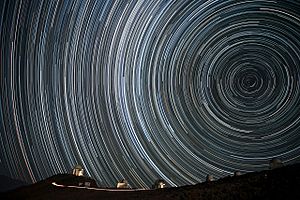
Solar Day
A true solar day is the time it takes for the Sun to appear in the same spot in the sky (like solar noon to solar noon). This time changes slightly throughout the year because of Earth's orbit around the Sun. Sometimes it's a bit longer, sometimes a bit shorter.
The average of all the true solar days in a year is called the mean solar day. This is exactly 86,400 mean solar seconds. Today, each of these seconds is a tiny bit longer than an SI second (the standard second) because Earth's mean solar day is a little longer than it was in the 1800s.
Stellar and Sidereal Day
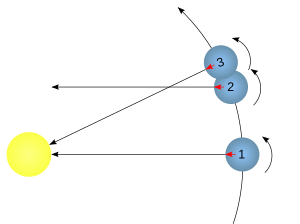
Earth's rotation period compared to very distant stars is called its stellar day. It's about 23 hours, 56 minutes, and 4.09 seconds.
The sidereal day is Earth's rotation period compared to a specific point in space called the "mean vernal equinox". It's slightly shorter than the stellar day, by about 8.4 milliseconds.
Both the stellar day and the sidereal day are about 3 minutes and 56 seconds shorter than our usual 24-hour mean solar day. This is because Earth spins one extra time relative to the distant stars as it travels around the Sun.
How Fast Earth Spins
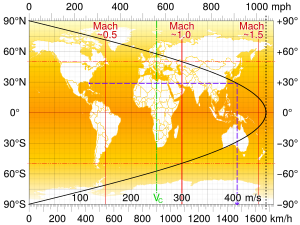
The speed at which Earth spins in space is about 7.292 x 10-5 radians per second. If you multiply this by the Earth's radius at the equator (about 6,378,137 meters), you get a speed of about 465.10 meters per second, or about 1,674.4 kilometers per hour (1,040 miles per hour).
The speed of Earth's rotation changes depending on your latitude (how far north or south you are from the equator). To find the speed at a certain latitude, you multiply the equatorial speed by the cosine of that latitude. For example, at the Kennedy Space Center in Florida (latitude 28.59° N), the speed is about 1,470.2 km/h. This is why spaceports are often built closer to the equator – to get a "boost" from Earth's spin!
The very top of the Cayambe volcano in Ecuador is the point on Earth's surface farthest from its axis. This means it spins the fastest as Earth rotates.
How Earth's Spin Changes
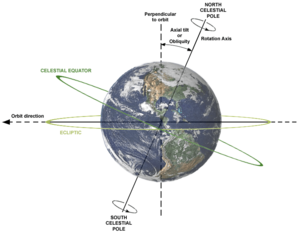
Changes in the Spin Axis
Earth's spin axis moves in space. These movements are called precession and nutation. The axis also moves a little bit compared to Earth's surface; this is called polar motion.
Precession is a slow wobble of Earth's axis, mainly caused by the gravity of the Sun and Moon pulling on Earth. Polar motion is mostly due to small wobbles inside Earth's core and a movement called the Chandler wobble.
Changes in Spin Speed
Moon's Pull
Over millions of years, Earth's rotation has slowed down a lot because of the Moon's gravity. This is called tidal acceleration. The Moon slowly takes away some of Earth's angular momentum (its spinning energy). This process has gradually made our days longer and has also caused the Moon to become tidally locked with Earth, meaning we always see the same side of the Moon.
Scientists have found evidence of this slowdown by studying ancient rock layers called tidal rhythmites and stromatolites. These show that the length of a day has steadily increased from about 21 hours 600 million years ago to the current 24 hours.
Big Events on Earth
Some big events on Earth can also change the length of a day. For example, the huge 2004 Indian Ocean earthquake actually shortened the day by 3 microseconds! This happened because it slightly changed how Earth's mass was spread out, which affected its moment of inertia (how hard it is to change its spin).
The melting of ice from the last ice age (called Post-glacial rebound) is still happening. As the land rises, it changes Earth's mass distribution, which also affects its spin speed. Even human-made structures can have a tiny effect. Scientists at NASA calculated that the water stored behind the Three Gorges Dam in China made Earth's day longer by 0.06 microseconds because of the shift in mass.
Measuring Earth's Spin Today
Scientists use very precise methods to monitor Earth's rotation. These include very-long-baseline interferometry (using radio telescopes), the Global Positioning System (GPS), and satellite laser ranging (bouncing lasers off satellites). These methods help them measure universal time and the movements of Earth's axis.
Ancient Observations of Spin
Ancient astronomers, like those in Babylonia and China (starting in the 8th century BCE), recorded solar and lunar eclipses. These old records are very useful! Scientists can use them to figure out how Earth's rotation has changed over the last 2,700 years. A change in day length of just milliseconds per century shows up as a change of hours and thousands of kilometers in eclipse observations. The ancient data confirms that days were shorter in the past, meaning Earth was spinning faster.
Where Earth's Spin Came From
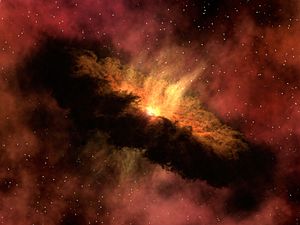
Earth's original spin is a leftover from the very beginning of our Solar System. Our Solar System formed from a giant cloud of dust, rocks, and gas. This cloud already had some angular momentum (it was slowly spinning). As this cloud collapsed and came together to form the Sun and planets, any slight unevenness in the cloud caused the planets to start spinning.
However, scientists believe that a huge collision happened about 4.5 billion years ago. A planet-sized object, sometimes called Theia, crashed into early Earth. This giant impact likely created our Moon and would have completely changed Earth's spin. After this huge crash, Earth probably had a day only about five hours long! Over billions of years, the Moon's tidal effects (its gravitational pull) then slowed Earth's spin down to its current speed.
Images for kids
- Allais effect
- Diurnal cycle
- Earth orientation parameters
- Formation and evolution of the Solar System
- Geodesy
- History of Earth
- Inner core super-rotation
- Nychthemeron
- Rossby wave
- Spherical Earth
- World Geodetic System
See also
 In Spanish: Rotación de la Tierra para niños
In Spanish: Rotación de la Tierra para niños


